|
Oakland Township
has the distinction of being one of the state's oldest townships. It was one of
the original 25 when the Territory of Michigan was organized in 1827.
The political
boundaries which are familiar to us today, mark a much smaller area than they
did in 1820 when the original divisions were made. At that time, the upper
three-fifths of Oakland County was declared to be Oakland Township, and the
lower two-fifths was designated Bloomfield Township. By an 1827 act of the
Michigan Territorial Legislature, Oakland Township lost ten townships but still
contained what are today Addison, Oxford, Orion, Oakland and Avon. As
settlement continued, boundaries changed several times, and in 1837 when
Michigan became a state Oakland was at its present size.
The geography of
the area, well elevated and regular except along its creeks, appealed to the
land hunters who entered the township one year after the first settler in
Oakland County, James Graham, built his homestead in what is today's Avon
Township.
After the
government land office opened in 1818, William Russell and Benjamin Woodworth
purchased parcels in Oakland Township on March 16, 1819, in Section 33. Other
parcels were purchased in 1824 and 1825, but it was not until 1826 that the
settlers erected log cabins. These settlers were Asa Baker, Benedict Baldwin,
Needham Hemingway, Josiah Dewey, Jeremiah Hunt, Joel Potter, Samuel Tower,
Russell Thurston, Ezra Newman, Ira and David Hammond, and James Coleman, all of
whom emigrated from Monroe County in New York state and settled in the western
part of the township. The following year Ezra Brewster also came from Monroe
County with his sons Peter, Owen, Stephen and Allen, and commenced to build a
pioneer's home. In 1829 William Snell came from New England, and William M.
Axford, who later became the first supervisor of Oakland Township, came from
New Jersey. Some prominent citizens who settled from 1831 to 1837 were: Isaac
Sisson from Buffalo; Ludlow Shadbolt, Calvin and William Fosdick and Jonathan
Carpenter from Duchess County, N.Y.; and Job Sherman from Ontario County, N.Y.
Others during these same years were: Sanford Swayze, Peter Kline, Martin Vail,
John Rodenbo, John Taylor, Shoups, Hixsons, Flumerfelts, Christopher Cole, and
Jacob Perry.
|
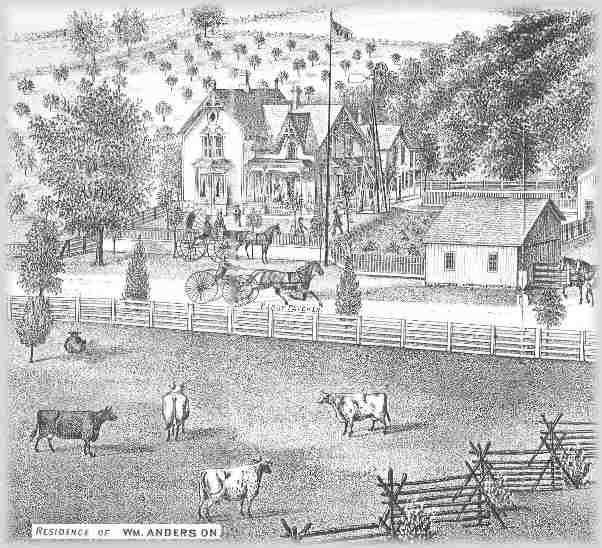
|
Other early settlers were: the Bromley brothers Sewell and Boswell from Vermont; Aaron Cook from Monroe County; Abraham Axford; David Brooks; Stephen Parish; Moses and George Snover; George Mercer; David Covel; Ira Youngs and William Chapman. Many of these early settlers became influential citizens in the township, many were excellent farmers, and many have
descendants here and in adjoining communities.
|
|
(Anderson Farm, above, on Letts Rd., circa 1870, shows dairy and orchard
industries important in our Township.)
Schools were built by the first settlers. One was built in 1827 in Section
29. History says it was a log building with a large fireplace that could
accommodate six-foot logs. The seats were arranged around the walls and
were made of slabs with legs cut from saplings growing on the site. In
1836 a log schoolhouse was built on Section 8 for 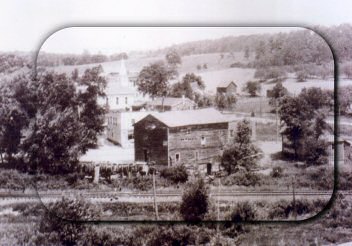 those living in the northern part of the township, and also in that year a schoolhouse of tamarack logs was built in the Kline settlement (Rochester and Stoney Creek Roads). By 1877 there were nine school districts in whole or in part in the township, namely Carpenter, Bigler, Clifton, Mt. Vernon, Snell, Kline, Baldwin, Eaton, and Brewster. The present modern Baldwin
School on Bannister Road was dedicated in the spring of 1927. It had existed as a one-room school for nearly a century on the corner of Orion and Gunn Roads. On moving day the pupils marched from the old structure to the new while the old school bell rang continuously. In 1952 a large portion of the township consolidated with Rochester, and other parts with Lake Orion and Romeo school districts. those living in the northern part of the township, and also in that year a schoolhouse of tamarack logs was built in the Kline settlement (Rochester and Stoney Creek Roads). By 1877 there were nine school districts in whole or in part in the township, namely Carpenter, Bigler, Clifton, Mt. Vernon, Snell, Kline, Baldwin, Eaton, and Brewster. The present modern Baldwin
School on Bannister Road was dedicated in the spring of 1927. It had existed as a one-room school for nearly a century on the corner of Orion and Gunn Roads. On moving day the pupils marched from the old structure to the new while the old school bell rang continuously. In 1952 a large portion of the township consolidated with Rochester, and other parts with Lake Orion and Romeo school districts.
Church groups in
the early days met in homes, and later in schools. History mentions revival
meetings in the Baldwin schoolhouse in 1827. Kline school was the meeting place
in 1837 for a group of Methodists, until 1855 when they built St. John's church
on the northeast corner of Buell and Rochester Roads. It thrived until 1887,
when it was moved to Collins Road in Goodison. In 1854 the Presbyterians also
began to meet at the Kline school, and in 1855 they built a church on the
southwest corner of Stoney Creek and Rochester Roads. The graveyard next to the
church marks the location today, and also contains the remains of those who had
previously been buried at a burial ground next to the Kline school across the
road. The Kline Presbyterian Cemetery and the Bigler Cemetery at Gunn and Kern
now belong to the township. The Paint Creek Cemetery on Orion Road near Lake
George was earlier called the Baldwin Cemetery and is owned and controlled by
the Paint Creek Cemetery Association. Before the days of hired caretakers, the
families of the association brought picnic dinners to its regular annual
meeting in August, and spent the day trimming bushes and attending the cemetery
business. On the fringes of the township, serving our community, were the
Oakland Baptist Church at Adams and Dutton; Seventh-day Adventist on Dutton at
Livernois, and Baptist and Methodist churches in Mt. Vernon.
Town meetings were
originally held in Rochester (then a part of Oakland Township), but the first
annual meeting within the present bounds of the Township was in 1835 at the
home of William Snell. Subsequent meetings were held in private homes until
1855 when a town house was created on Section 15 on Buell Road. In the early
1900s the Gleaner Hall on Collins Road served as the political and social
center. It stood on the lot adjacent to the present town hall, which was built
in 1938.
A post office was established in Goodison in 1874. It had a daily mail,
and L.P. Tower was the first postmaster. Later postmasters were: William
Goodison, Jr.; William Toms and 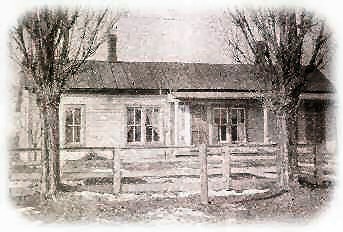 daughter Mary Toms Barkham; Ellen Collins; and Mrs. Blair. The post office did not have its own building but was housed in various stores. One of these was Billy Wangalien's, which is still remembered fondly by residents who recall going there for after-school candy. This store was adjacent to the Goodison Mill. Mr. Wangalien and his son-in-law Art Fox built a new store across
the road on the site of the present Rochester Gear Works, and it was moved to its present location on Territorial Road in 1950. In earlier years there had been a trading post on Axford property at Gunn and Rochester Roads, and a small store in Section 30 owned by John P. LeRoy. daughter Mary Toms Barkham; Ellen Collins; and Mrs. Blair. The post office did not have its own building but was housed in various stores. One of these was Billy Wangalien's, which is still remembered fondly by residents who recall going there for after-school candy. This store was adjacent to the Goodison Mill. Mr. Wangalien and his son-in-law Art Fox built a new store across
the road on the site of the present Rochester Gear Works, and it was moved to its present location on Territorial Road in 1950. In earlier years there had been a trading post on Axford property at Gunn and Rochester Roads, and a small store in Section 30 owned by John P. LeRoy.
The Goodison Grist Mill on Paint Creek was built in 1835 by Needham Hemingway. The water power was generous and did not require the usual mill pond. He dug a mill race from a half-mile upstream, and instead of the usual waterwheel, a box-flume fed the water under 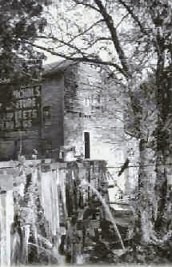 Gallagher Road (then the old Tower Road) into the basement of the mill, where it turned a turbine. This engaged a shaft that reached up to the second story and turned the mill stones. In 1877 the mill was improved and enlarged by William Goodison. Later owners of this mill were William Toms, Sam Barnes, and in its declining years, Maurice Collins and son-in-law Frank Voll. It ceased grinding during World War II. In the 40s, after more than a century of service, and having passed the point
of preservation it was reluctantly dismantled by its latest owner, Dale Miller, and the present Paint Creek Cider Mill was built. Gallagher Road (then the old Tower Road) into the basement of the mill, where it turned a turbine. This engaged a shaft that reached up to the second story and turned the mill stones. In 1877 the mill was improved and enlarged by William Goodison. Later owners of this mill were William Toms, Sam Barnes, and in its declining years, Maurice Collins and son-in-law Frank Voll. It ceased grinding during World War II. In the 40s, after more than a century of service, and having passed the point
of preservation it was reluctantly dismantled by its latest owner, Dale Miller, and the present Paint Creek Cider Mill was built.
Stoney Creek
supplied the power for two other mills in the township. The James Hersey Saw
Mill was located near where the stream crosses East Gunn Road in Section 23.
Built by Arnon Baker in 1836, it was purchased by Hersey in 1839. It was run by
him until 1877, then by his son-in-law Charles Coryell until 1890. Another
mill, saw and grist, was a half-mile south of the Hersey, on the same creek,
where it crosses Snell Road into Section 26. Built in the 1830s it was run by
the Wilber family during four generations, beginning with Elon Dudley and
ending with Howard Wilber in the 1920s.
Blacksmith shops
were much needed in the early days, and our township was well supplied:
Gerilot's on West Predmore; Dernberger's (later Campbell's) at Rochester and
Romeo Roads (1842); Metz's at Dequindre and Inwood; "Uncle H"
Halsted's on Silverbell (1828) and the Maurice Collin's at Goodison
(1872-1935).
Other craftsmen in
the township included Robert Barkham's great-grandfather, William Toms, who was
a cobbler in his home on Collins Road, and Clarence Kremer's father, Frank, who
built buggies and wagons in a shop beside his house on Dutton Road.
The Detroit and
Bay City Railroad was built through the township in 1872, and established a
" flag" station at Goodison. The grist mill and post office were both
run by Goodisons at that time, so the crossing was called "Goodison's
Station." It was a busy center. Folks gathered at the
store-and-post-office located next to the mill, and there was much activity at
Maurice Collin's blacksmith shop adjacent on the south. Long freight trains
were switched on the sidings along the tracks which lay to the north and to the
south from Goodison. A third short siding and weighing platform served local
farmers who loaded grain and potatoes for market, and likewise at Rudd's Mill
Crossing at Clarkston Road. A one-car passenger train went daily north to Bay
City in the mornings and back in the afternoons until about 1950, when
passenger service was discontinued. At about the same time steam engines were
replaced by diesels. In the first quarter of this century the railroad serviced
a thriving sand-and-gravel operation along its course, traces of which remain,
south of Silverbell and north of Gunn.
A branch of the Detroit (electric) United Railway was built through Goodison in 1900 and 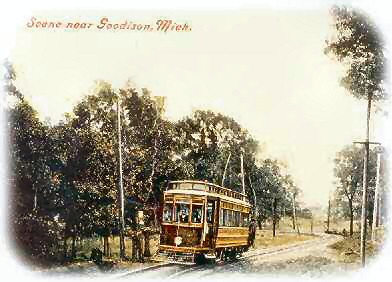 went north to Orion, Oxford, and Flint. In Goodison its track lay along what now is called Territorial Road. There was a substation there, where local dairy
farmers brought their daily milk cans for the DUR to transport to Detroit creameries. A passenger waiting station stood on the site of the present Rochester Gear Works; others were located at several road crossings through the township. Many of the local youth rode the DUR to high school at Orion or Rochester. The fare was a nickel. On weekends extra excursion cars were run, to carry vacationers to Lake Orion for boat rides and lakeside attractions. When the automobile arrived, use of the DUR by passengers dropped
off, and trucks became the transportation for milk. In 1933 the line was discontinued. went north to Orion, Oxford, and Flint. In Goodison its track lay along what now is called Territorial Road. There was a substation there, where local dairy
farmers brought their daily milk cans for the DUR to transport to Detroit creameries. A passenger waiting station stood on the site of the present Rochester Gear Works; others were located at several road crossings through the township. Many of the local youth rode the DUR to high school at Orion or Rochester. The fare was a nickel. On weekends extra excursion cars were run, to carry vacationers to Lake Orion for boat rides and lakeside attractions. When the automobile arrived, use of the DUR by passengers dropped
off, and trucks became the transportation for milk. In 1933 the line was discontinued.
History moves on.
Increasing numbers of new settlers are moving in, attracted by the historic and
rural character of the area, and by the rolling scenic beauty of its land and
streams. Residential developments are being laid out in some of the abandoned
old fields. Farming has changed. The plow, though much different in style,
still plays a part in the use of the land.
The preceding is excerped from the booklet, HERITAGE
IN OAKLAND TOWNSHIP, Editors: Delta Kelly and Barbara Kandarian, Oakland
Township Historical Society, June 1976.
|
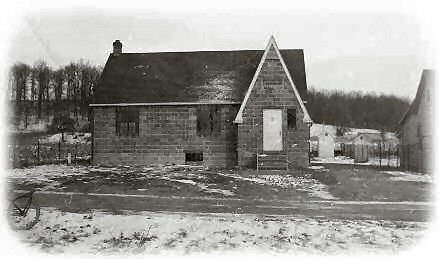
|
The township hall in Goodison was built in 1938 of cement block with an
English Tudor influence common for municipal buildings at that time.
It was used for meetings and social events. In the 1972 Clerk Carolyn Phelps had an office in the building. It was later sided and additions were made
to accommodate more township office space.
Today, the hall is home to the police substation.
|
|
|

